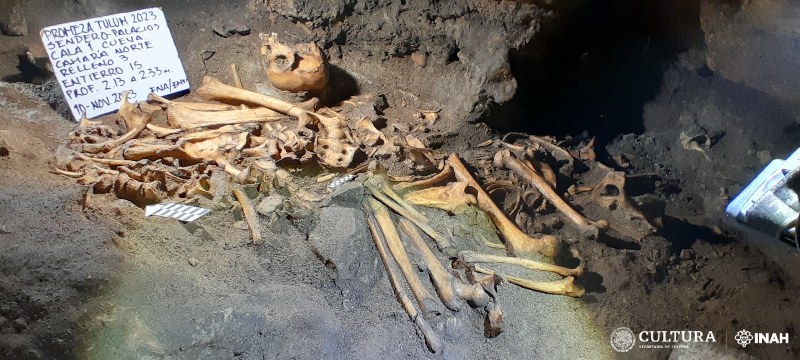You can find all kinds of cool things in caves. From pearls to softball-sized spiders, ancient human artwork, and even unicorns, there’s no telling what awaits the curious cave explorer. Nothing illustrates this fact more clearly than the surprise that greeted archaeologists in Mexico recently, when they rolled back a boulder to discover a true cave of wonders – if your definition of “wonders” includes a load of human and animal bones, that is.
The discovery was made in Tulum by scientists from the National Institute of Anthropology and History (INAH) working on a project for the federal Ministry of Culture. While working to open up a new pathway between two excavated buildings, they found a boulder adorned with a sea snail stuck to the rock, remnants of the ancient decoration left by the pre-Hispanic Maya inhabitants of the region.
“When removing the rock that closed the entrance to the cavity, it was observed that it was literally splitting the bone remains of an individual, leaving the lower part of his body on the outside and the upper part inside it,” said project coordinator José Antonio Reyes Solís in a statement.
That’s right: when they rolled the boulder aside to enter the cave, they found that it was sitting on top of the remains of an unfortunate human, cutting the skeleton straight down the middle.
With an opener like that, it was clear the cave would be worth exploring. It was quickly found to be made up of at least two small chambers, each only around 3 meters (9.8 feet) by 2 meters (6.5 feet) in size, and with an average height of just 50 centimeters (19.6 inches). Up to now, eight human burial sites have been identified within the chambers, mostly of adults, which are well-preserved thanks to the favorable environmental conditions.

Just some of the remains that were excavated.
Image credit: Proyecto de investigación Promeza, Tulum/Jerónimo Aviles Olguin
But it’s not only human bones that have been uncovered. The team sought the expertise of Jerónimo Avilés and Cristian Sánchez, both specialists in the identification of animal remains, and it appears the small cave contains a veritable Noah’s Ark of fauna. Preliminary analysis revealed at least nine species of mammals – including blood-sucking bats and domestic dogs – along with various birds, reptiles, fish – including tiger sharks – crustaceans, snails, and frogs.
Some of the bones show signs of cutmarks and modifications, suggesting they had been fashioned into various artifacts typical of the region, such as needles. A large number of ceramic fragments were also found at the site.

A member of the team sheds some light on the finds.
Image credit: Proyecto de investigación Promeza, Tulum/Jerónimo Aviles Olguin
Working inside the cave has been challenging for the team, who have had to grapple not only with the cramped space but also the lack of light, high heat and humidity, and unwelcome insect inhabitants. Luckily, the researchers have at their disposal modern tech like high-resolution photography and laser scanners, and plan to construct precise 3D models of the cave so that this fascinating site can be preserved for the future.

Working in such close quarters has not been easy for the team.
Image credit: Proyecto de investigación Promeza, Tulum/Jerónimo Aviles Olguin.
And if you can’t make it to Mexico any time soon, you’re in luck: INAH says it plans to use these models not only for research, but to make a virtual tour of the cave accessible to the public, so even the most claustrophobic of budding explorers can venture inside this ancient mortuary.
Source Link: Sealed-Off Cave Opened To Reveal Human Skeletons, Along With Tiger Sharks And “Blood-Sucking” Bats